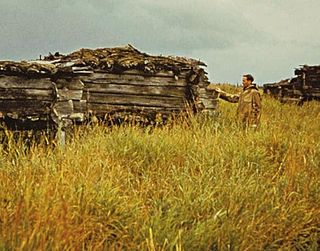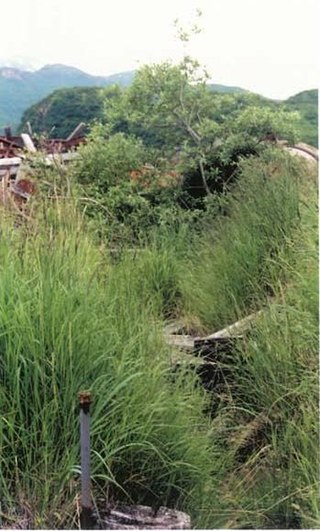
Katmai National Park and Preserve is an American national park and preserve in southwest Alaska, notable for the Valley of Ten Thousand Smokes and for its brown bears. The park and preserve encompass 4,093,077 acres, which is between the sizes of Connecticut and New Jersey. Most of the national park is a designated wilderness area. The park is named after Mount Katmai, its centerpiece stratovolcano. The park is located on the Alaska Peninsula, across from Kodiak Island, with headquarters in nearby King Salmon, about 290 miles (470 km) southwest of Anchorage. The area was first designated a national monument in 1918 to protect the area around the major 1912 volcanic eruption of Novarupta, which formed the Valley of Ten Thousand Smokes, a 40-square-mile (100 km2), 100-to-700-foot-deep pyroclastic flow. The park includes as many as 18 individual volcanoes, seven of which have been active since 1900.

The Amalik Bay Archeological District is a geographic area with a significant number of archaeological sites in Alaska. It is located on the Pacific coast of Katmai National Park and Preserve, in the mainland portion of Kodiak Island Borough, Alaska.

The Brooks River Archaeological District encompasses a large complex of archaeological sites along the banks of the Brooks River in Katmai National Park and Preserve in the U.S. state of Alaska. It includes at least twenty separate settlement sites with documented occupation dates from 2500 BCE to recent (post-contact) history. It was declared a National Historic Landmark in 1993. The site is partly occupied by the Brooks Camp, one of the major visitor areas of the park.

Yukon Island is an island in outer Kachemak Bay, an inlet of the Cook Inlet of south central Alaska. The island is located about 9 miles (14 km) south of Homer. The island is archaeologically sensitive, with a number of sites documenting the prehistory of the bay. The Yukon Island Main Site, a National Historic Landmark, is a major shell midden site at which the pioneering archaeologist Frederica de Laguna was able to sequence 1500 years of the area's prehistory, and other sites have been found on the island since then. The island is now home to an educational retreat center.

This is a list of the National Register of Historic Places listings in Kenai Peninsula Borough, Alaska.

This is a list of the National Register of Historic Places listings in Kodiak Island Borough, Alaska.

This is a list of the National Register of Historic Places listings in Lake and Peninsula Borough, Alaska, United States.

Kijik (Dena'ina: Qizhjeh) is a ghost town in Lake and Peninsula Borough, Alaska, United States. An Athabascan village that was established on the shores of Lake Clark in the Alaska Range, its population was recorded at 91 in the 1880 United States Census and declined thereafter, falling to approximately 25 individuals by 1904. Today, the village has been abandoned. The ghost town is located within the bounds of Lake Clark National Park and Preserve.
This is a list of the National Register of Historic Places listings in Lake Clark National Park and Preserve.
This is a list of the National Register of Historic Places listings in Katmai National Park and Preserve.

The DIL-161 Site is a prehistoric archeological site in Katmai National Park and Preserve. Located on the banks of the Alagnak River, the site was first identified in 1997 by National Park Service personnel, and its extents were mapped in 2004. The site is that of a village that was occupied between about 300 BCE and 800 CE. More than 40 cabin sites, which are little more than house pits, have been identified.
The Port Moller Hot Springs Village Site is a prehistoric archeological site on the Alaska Peninsula. It is located on the shores of Moller Bay, an indentation on the peninsula with extensive tidal flats. Until historical times the area was a border region between the Aleut and the Inuit. The site is notable for the presence of a sulphurous hot spring, which provides drinkable water. The 50-acre (20 ha) site contains the remains of a native village and extensive refuse middens. The site was first excavated in 1928.

The Old Savonoski Site is the former site of a native village in Lake and Peninsula Borough, Alaska, that was buried by ash in the June 1912 eruption of the Novarupta Volcano. The site is located near the confluence of the Savonoski and Ukak Rivers, and is within the bounds of the Katmai National Park and Preserve. The site was visited by archaeologists in 1953, who identified a number of surviving elements, including fifteen barabaras, or semi-subterranean dwellings.
Chugachik Island is a small island in the upper reaches of Kachemak Bay, an indent in the Kenai Peninsula of south-central Alaska. The island falls within the bounds of Kachemak Bay State Park.

The Kukak Bay Cannery was a commercial razor clam canning operation on the southern coast of the Alaska Peninsula. The cannery operated intermittently from 1922 to 1951, with its most active years before 1936, when most of its complex was destroyed by fire.
The Kaguyak Village Site, designated 49 Afg 4, is a historic and prehistoric archaeological site on the Pacific coast of the Alaska Peninsula in Katmai National Park and Preserve. It is the site of an Alaska Native village which was abandoned after the eruption of Novarupta in 1912. The historic elements of the site include the remains of a Russian Orthodox church and cemetery, as well as a number of frame house remnants and foundations.
Takli Island is an island off the southern coast of the Alaska Peninsula in the Shelikof Strait of southwestern Alaska. It is located at the mouth of Amalik Bay, off the mainland portion of Kodiak Island Borough, in Katmai National Park and Preserve. The area was first archaeologically investigated in the 1960s, when the prehistory of the area was little known, and the island's sites are type sites for a series of archaeological cultures.
The Kasna Creek Mining District encompasses a historic copper mining claim on the Alaska Peninsula of southwestern Alaska. The claim is located in the watershed of Kasna Creek, located on the south side of Kontrashibuna Lake, east of Port Alsworth, and was first staked in 1906 by Charles Brooks and Count Charles Von Hardenberg. They were reported in 1909 to have built a house and storage building near the mouth of the creek. Although never developed, the claim continued to be of interest to mining companies into the 1950s, and was initially excluded from the nearby Lake Clark National Park and Preserve because of outstanding claims.
The Moose River Site is a prehistoric archaeological site in Kenai Peninsula Borough, Alaska. Located near the confluence of the Kenai and Moose Rivers near Sterling, it is apparently a camp or village site that was used as a fishing camp about 1500 years ago. The site includes seven house pits and three food cache pits.
The Savonoski River Archeological District encompasses a complex of prehistoric and historic archaeological sites on the Savonoski River near the mouth of the Grosvenor River in Katmai National Park and Preserve, located on the Alaska Peninsula of southwestern Alaska. At least two sites, designated 49-MK-3 and 49-MK-4 by state archaeologists, were identified when the site was listed in 1978. In 2003, the district was enlarge to include a third site, XMK-53. This area is believed to be the site of one of a group of Native Alaskan settlements referred to in Russian records as "Severnovsk". Excavations of a known prehistoric site in 1964 uncovered additional evidence of a post-contact settlement.













